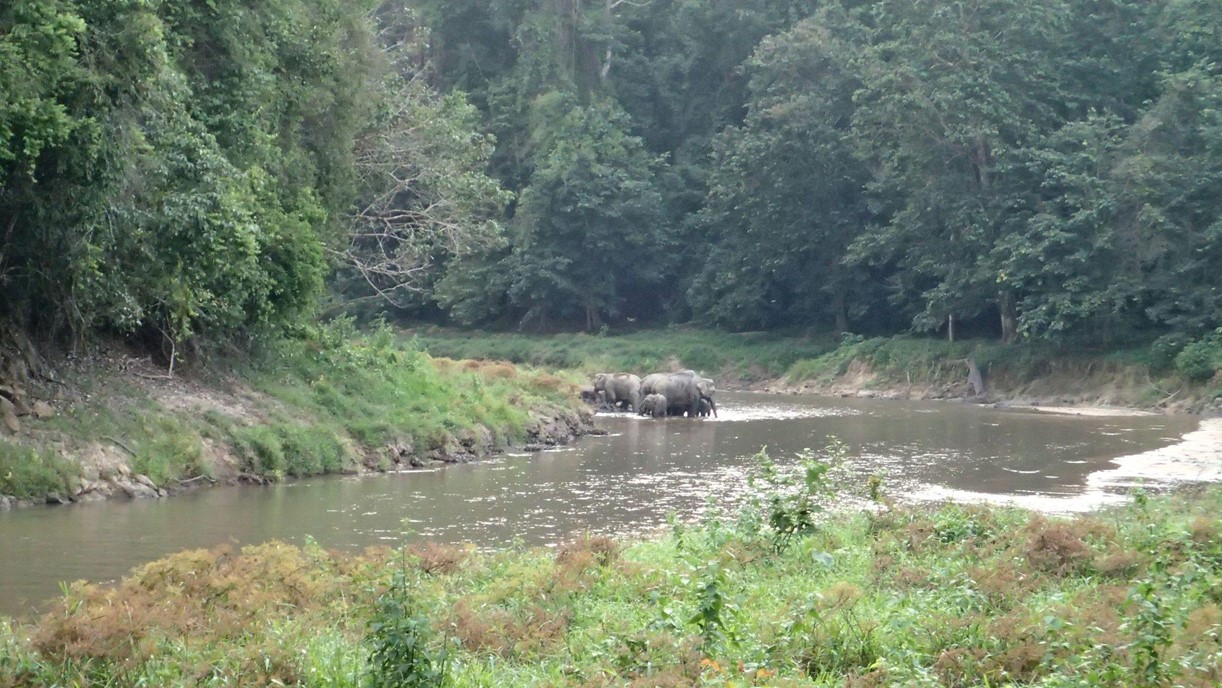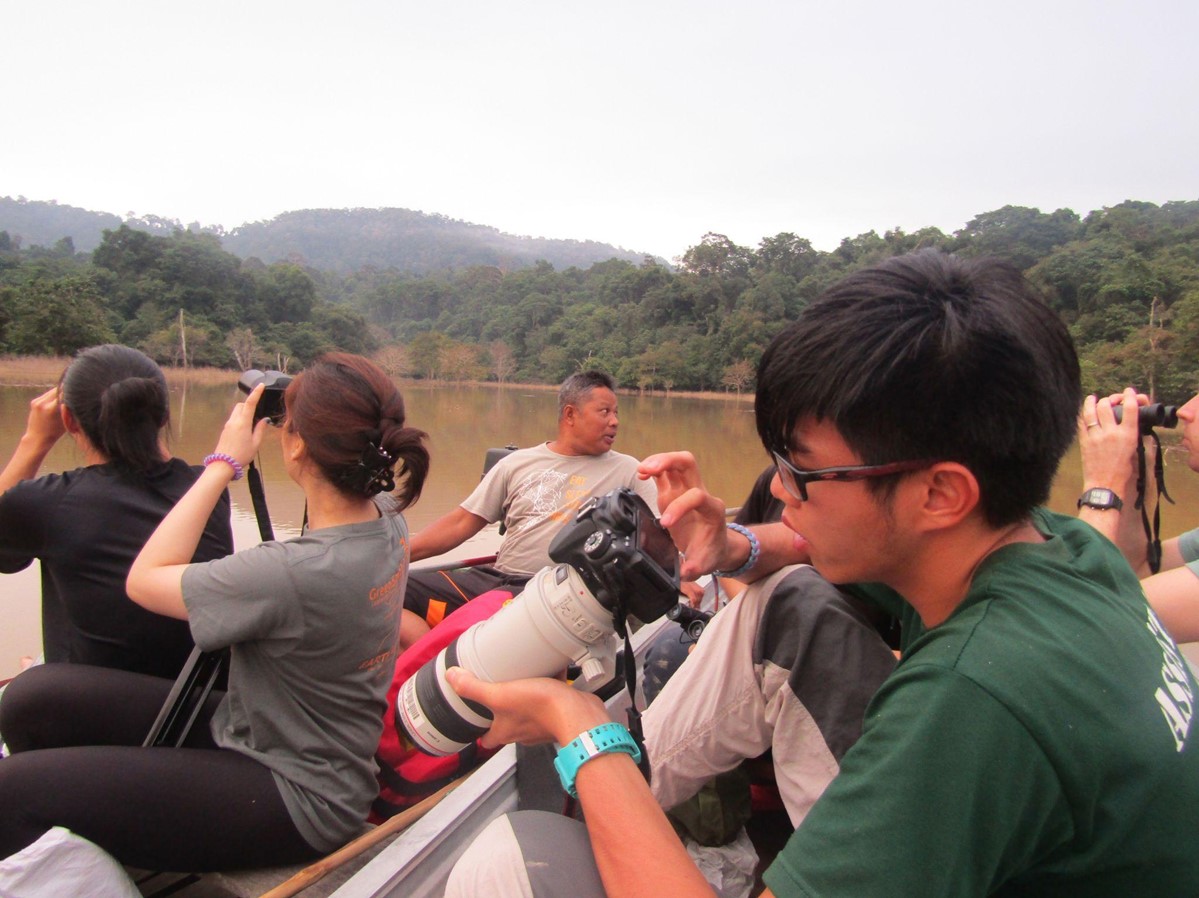Experts share dos and don’ts to get the most out of your wildlife tours, while leaving minimal impact on the environment.
In mid-2014, I visited Earth Lodge Malaysia, a low-impact tour operator in the Ulu Muda rainforest with my husband Jonathan back when I had just started settling into Malaysia. It was our first experience deep in the rainforests of the peninsular and by wonderful luck, we were able to witness a small group of elephants drinking minerals at one of the many active salt licks near the vicinity of the lodge.
I was gobsmacked. These intelligent eyes watched us wearily, as a playful young elephant stuck its head out from behind and raised its little trunk clumsily.
Experiences like these have given me valuable perspectives of how important and special Malaysian wildlife is. It is the reason that I have returned time and time again to Ulu Muda, bringing young Malaysians (through non-profit organisation GreenSmiths) to learn about their natural heritage, inviting them to be awed by our native wildlife.
Mineral licks, or salt licks, are special areas where essential minerals are pushed up to the surface through geothermal activity. These areas attract a large range of biodiversity as the wildlife visits the salt licks to ingest these minerals.
If managed well, ethical guiding tours can be a consistent way to learn more about the wildlife populations in an area and cultivate powerful lasting memories – just like in Ulu Muda where one can witness the majesty and intelligence of Asian elephants in the wild.

Hymeir and guides inform visitors about a salt lick in Ulu Muda. Photo by Hii Ning from Management & Ecology of Malaysia’s Elephants (MEME).
A study in 2021 by WWF found at least 15 species of regular visitors to salt lick areas in Ulu Muda, including the Malayan tapir (Tapirus indicus), sambar deer (Rusa unicolor), barking deer (Muntiacus muntjak), wild boar (Sus scrofa), pig-tailed macaque (Macaca nemestrina) and of course the Asian elephant (Elephas maximus).
But this report, like many, highlights the fragility of these areas and the potential damage of human interactions. As a result, operators and visitors should stick to the following ethical guidelines whenever entering such environments.

A group of elephants with young at Sira Gaja, Ulu Muda. Photo by GreenSmiths.
Guidelines for ethical wildlife tours at Earth Lodge
Dr Ahmad Zafir of The Habitat Foundation has been working in wildlife conservation for 20 years. He volunteers as a guide at Earth Lodge, supporting fellow naturalist Hymeir Kamarudin, the Lodge’s founding director.
As nature guides, they believe that Ulu Muda is one of the best places to see wild elephants in Peninsular Malaysia. But these areas are fragile, with delicate ecosystems that can only continue to thrive if there is careful management of human impacts.

Small group river cruises in Ulu Muda. Photo by GreenSmiths.
1. Go in small groups
Earth Lodge organises very limited group sizes to purposefully ensure there is reduced negative impact from human activity (noise, waste, etc). A boat may hold three to four participants at absolute maximum, and only one to two guides. This means that an ideal group size should range from six to eight people only. The aim is to limit the impact any additional noise, smell, and waste might have on wildlife.
2. Listen and wait patiently for the guide’s instructions
Ulu Muda is generally a flatland forest which is suitable habitat for large animals, but rainforests are not like safari on the savannah. Animals, even those as large as elephants, can hide in the thick foliage even as you pass by on foot or by boat.
It can be tempting to go ahead of your guide to look for signs, but this can be dangerous, as well as have a negative impact on both the animals’ well being, and your chance of seeing them.
Guides will know more about the animal behaviour, where they like to roam, and how they may detect the presence of humans. They will instruct you on the best routes, places to watch from, and correct pace to move. Keep your voices down and avoid bringing noisy packaging or items so as to keep disturbances to a minimum.

Visitors from a local university keep their distance from wildlife in the boat. Photo by Jonathan Lai, GreenSmiths.
3. If you see something, don’t approach
Watching an animal’s natural behaviour when it is not alerted to human presence is the best kind of ethical nature viewing. If you see an animal whilst on the boat or land, try not to move too much unless you are backing away to ensure you are a safe distance from the animal.
When we see elephants, we normally ensure we stay a minimum of 80 to 100 metres away. If you do need to adjust your spacing, move slowly without sudden movements so as not to scare them.
You should never approach an elephant – this is extremely dangerous. Some human-elephant interactions have been fatal where the elephant felt that it was at risk. This is particularly true for elephants protecting younger offspring within their group.

Local and international tourists spot wildlife from the river cruise with help from the boatmen and guides. Photo by GreenSmiths.
4. Bring the right viewing equipment
Since it is advised to keep your distance, a pair of good binoculars and/or a camera with a good sized photo lens is a must.
Be cautious at night about using bright, white torch light to illuminate animals. Whilst this can be helpful for spotting, the intensity of the light can affect the animal’s vision – and yours and your fellow guests.
If you do spot an animal, try and face the torchlight slightly away to the side so it is not straight into their eyes. Even better if you can use a red filter which will dull the light for the animal.
5. The rainforest is a buffet – don’t feed animals
We have often heard of scenarios where people feed forest animals because they have been concerned about their lack of food sources, but this normally is the result of misinformation. Rainforests provide all the necessary food and minerals for the animals, and their waste feeds the soils from which more of their food grows.
Humans introducing non-sustainable and non-natural food sources severely damages this equilibrium and the natural health of both animals and plants. Don’t leave your food and don’t throw food scraps into the water or forest.
6. Take all your trash out – or don’t bring harmful things into the forest in the first place
This includes wrappers, plastic bottles, uneaten food – but even the shampoo you use or synthetic fibres on clothes can leave a trace. When you’re sitting in a hide overlooking the salt lick, you want to not only hide your visual presence but make yourself hard to smell too!
How about wearing clothes from natural materials rather than synthetics which tend to trap bacteria between their fibres and make you smell more strongly? How about not wearing makeup, cologne, or other synthetic scents when you visit? Get back to your natural version.
7. The rainforest is a buffet – but not for you
Finally, you have probably heard the phrase ‘take nothing but photographs, leave nothing but footprints’. Rainforests can provide ample food sources for animals and even for people. You might be tempted to try a juicy looking berry, but nowadays, very few people have sufficient knowledge to understand what is safe to eat. Our recommendation is not to try.
8. Don’t make new paths and trails
In addition, don’t damage the plants by cutting or stamping – even if you want to try and improve your viewing spot, you’re more likely to alert the animal to your presence, and do damage to the ecosystem in the surrounding areas. If a trail is blocked by fallen debris, leave it to your guide to manage.
9. Don’t leave with anything that isn’t yours
Finally, never take any items out as souvenirs – the forest is a circular flow of energy where every nutrient goes back into its ecosystem.

A morning river cruise leaving Earth Lodge. Photo by GreenSmiths.
Let us leave the forest in the best way; we can envisage that one day, long into the future, our descendants might also have the unique experience of watching a healthy Asian elephant and their young happily slurping up minerals from a salt lick, unperturbed or harmed by our existence.
Visit Earth Lodge
Follow Friends of Ulu Muda
Learn more from Management & Ecology of Malaysian Elephants (MEME)
Read more about Earth Lodge A Stay in the Heart of Malaysia’s Ancient Rainforests
Writer: Chrissy Lind-Hunter (GreenSmiths/The Habitat Foundation)
Contributors: Hymeir Kamarudin (Earth Lodge Malaysia) and Dr Ahmad Zafir (The Habitat Foundation)

